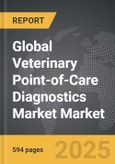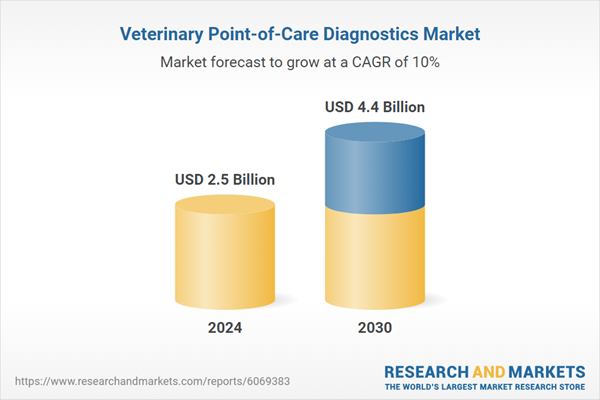Global Veterinary Point-of-Care Diagnostics Market - Key Trends & Drivers Summarized
Why Is Veterinary Point-of-Care Diagnostics Becoming Essential in Animal Healthcare?
Veterinary point-of-care (POC) diagnostics have revolutionized the way veterinarians diagnose and manage diseases, enabling rapid and accurate on-site testing without the need for external laboratory facilities. With increasing pet ownership and growing awareness of preventive healthcare, veterinarians and pet owners alike are demanding faster diagnostic solutions that allow for immediate treatment decisions. The ability to diagnose conditions such as infections, organ dysfunction, metabolic disorders, and infectious diseases within minutes has significantly improved the efficiency of veterinary care. Additionally, the rise in zoonotic diseases has heightened the importance of early disease detection, particularly in livestock and food-producing animals where timely intervention can prevent outbreaks and safeguard public health. Equine and exotic animal veterinarians are also benefiting from POC diagnostics, as these portable devices enable field testing in remote locations without access to traditional laboratory infrastructure. The shift towards evidence-based veterinary medicine is further driving the adoption of POC diagnostic tools, allowing veterinarians to provide data-driven treatment plans with greater accuracy and confidence.What Are the Latest Innovations in Veterinary Point-of-Care Testing?
Advancements in veterinary POC diagnostics have led to the development of highly sophisticated testing devices that offer greater accuracy, efficiency, and ease of use. One of the most notable breakthroughs is the introduction of portable analyzers that can conduct a wide range of tests, including hematology, biochemistry, and electrolyte analysis, within a single compact system. The integration of artificial intelligence (AI) and machine learning algorithms into POC devices is enhancing diagnostic accuracy by reducing human error and automating result interpretation. Additionally, the development of immunoassay-based rapid test kits for conditions such as parvovirus, heartworm disease, feline leukemia, and tick-borne infections has made disease detection more accessible in routine veterinary practice. The rise of microfluidic-based diagnostic platforms has further improved the precision and speed of testing, allowing for real-time blood analysis with minimal sample volumes. Another major innovation is the growing adoption of cloud-connected POC devices, enabling veterinarians to store and share test results instantly with specialists for remote consultation and second opinions. As these technological advancements continue to evolve, POC diagnostics are becoming an integral component of modern veterinary practice, providing immediate and actionable insights for improved patient care.What Challenges Exist in the Veterinary Point-of-Care Diagnostics Market?
Despite its rapid adoption, the veterinary POC diagnostics market faces several challenges that impact its growth and accessibility. One of the primary concerns is the cost of advanced POC testing equipment, which can be a financial burden for small and independent veterinary clinics. While these devices offer long-term benefits, the initial investment and ongoing consumable costs can limit adoption, particularly in developing regions. Additionally, the accuracy and reliability of some POC tests remain a concern, as variations in sample quality, operator proficiency, and environmental factors can impact test results. Regulatory approval processes for new diagnostic technologies also present challenges, as stringent validation protocols are required to ensure compliance with veterinary health standards. Another obstacle is the limited availability of species-specific diagnostic tests, as many POC devices are designed for commonly treated animals such as dogs and cats, leaving a gap in diagnostics for exotic and wildlife species. Furthermore, the lack of standardization among different POC testing platforms can create interoperability issues, making it difficult for veterinarians to integrate results into centralized patient records. Overcoming these challenges requires continued research, cost-effective product development, and enhanced training for veterinarians and technicians to maximize the potential of POC diagnostic tools.What Are the Key Growth Drivers of the Veterinary Point-of-Care Diagnostics Market?
The growth in the veterinary POC diagnostics market is driven by several factors, including increasing demand for rapid and accurate testing, rising pet healthcare expenditures, and advancements in diagnostic technology. The expansion of companion animal healthcare services has led to a greater emphasis on immediate diagnosis and treatment, fueling the demand for POC devices that enhance clinical decision-making. The growing prevalence of chronic diseases, such as diabetes and kidney disorders in pets, has further driven the need for on-site diagnostic monitoring solutions. In livestock and poultry industries, the push for disease prevention and food safety has accelerated the adoption of portable testing kits that enable real-time monitoring of herd and flock health. The increasing availability of cloud-based data sharing and telemedicine integration is also playing a significant role in market expansion, allowing veterinarians to make more informed treatment decisions remotely. Additionally, the rising number of veterinary diagnostic startups and investments in veterinary health technology are contributing to the development of innovative POC solutions that cater to a broader range of animal species. With ongoing advancements and growing awareness of the benefits of rapid diagnostics, the veterinary POC diagnostics market is expected to experience significant growth in the coming years.Report Scope
The report analyzes the Veterinary Point-of-Care Diagnostics market, presented in terms of market value (US$). The analysis covers the key segments and geographic regions outlined below:- Segments: Animal Type (Companion Animals, Livestock Animals); Product (Consumables, Reagents, & Kits, Instruments & Devices); Testing Category (Hematology, Diagnostic Imaging, Bacteriology, Virology, Cytology, Clinical Chemistry, Parasitology, Serology, Others); Sample Type (Infectious Disease, General Ailments, Others); Indication (Blood / Plasma / Serum, Urine, Fecal, Others).
- Geographic Regions/Countries: World; United States; Canada; Japan; China; Europe (France; Germany; Italy; United Kingdom; Spain; Russia; and Rest of Europe); Asia-Pacific (Australia; India; South Korea; and Rest of Asia-Pacific); Latin America (Argentina; Brazil; Mexico; and Rest of Latin America); Middle East (Iran; Israel; Saudi Arabia; United Arab Emirates; and Rest of Middle East); and Africa.
Some of the 48 companies featured in this Veterinary Point-of-Care Diagnostics market report include -
- Agrolabo S.p.A.
- AniPOC Ltd.
- bioMérieux SA
- BioNote, Inc.
- Covetrus
- Deciphex Limited
- ESAOTE S.p.A.
- FUJIFILM Corporation
- Getein Biotech
- Heska Corporation
- IDEXX Laboratories, Inc.
- iM3Vet Pty Ltd.
- INDICAL BIOSCIENCE GmbH
- Merck KGaA
- Mindray Animal Medical Technology
- Neogen Corporation
- NeuroLogica Corp.
- Randox Laboratories Ltd.
- Scopio Labs
- Techcyte
Key Insights:
- Market Growth: Understand the significant growth trajectory of the Companion Animals segment, which is expected to reach US$3.1 Billion by 2030 with a CAGR of a 11.2%. The Livestock Animals segment is also set to grow at 7.5% CAGR over the analysis period.
- Regional Analysis: Gain insights into the U.S. market, valued at $674.1 Million in 2024, and China, forecasted to grow at an impressive 13.9% CAGR to reach $906.9 Million by 2030. Discover growth trends in other key regions, including Japan, Canada, Germany, and the Asia-Pacific.
Why You Should Buy This Report:
- Detailed Market Analysis: Access a thorough analysis of the Global Veterinary Point-of-Care Diagnostics Market, covering all major geographic regions and market segments.
- Competitive Insights: Get an overview of the competitive landscape, including the market presence of major players across different geographies.
- Future Trends and Drivers: Understand the key trends and drivers shaping the future of the Global Veterinary Point-of-Care Diagnostics Market.
- Actionable Insights: Benefit from actionable insights that can help you identify new revenue opportunities and make strategic business decisions.
Key Questions Answered:
- How is the Global Veterinary Point-of-Care Diagnostics Market expected to evolve by 2030?
- What are the main drivers and restraints affecting the market?
- Which market segments will grow the most over the forecast period?
- How will market shares for different regions and segments change by 2030?
- Who are the leading players in the market, and what are their prospects?
Report Features:
- Comprehensive Market Data: Independent analysis of annual sales and market forecasts in US$ Million from 2024 to 2030.
- In-Depth Regional Analysis: Detailed insights into key markets, including the U.S., China, Japan, Canada, Europe, Asia-Pacific, Latin America, Middle East, and Africa.
- Company Profiles: Coverage of players such as AB Vista, Alltech, Bayer AG, Biomin Holding GmbH, Boehringer Ingelheim and more.
- Complimentary Updates: Receive free report updates for one year to keep you informed of the latest market developments.
Select Competitors (Total 48 Featured):
- Agrolabo S.p.A.
- AniPOC Ltd.
- bioMérieux SA
- BioNote, Inc.
- Covetrus
- Deciphex Limited
- ESAOTE S.p.A.
- FUJIFILM Corporation
- Getein Biotech
- Heska Corporation
- IDEXX Laboratories, Inc.
- iM3Vet Pty Ltd.
- INDICAL BIOSCIENCE GmbH
- Merck KGaA
- Mindray Animal Medical Technology
- Neogen Corporation
- NeuroLogica Corp.
- Randox Laboratories Ltd.
- Scopio Labs
- Techcyte
This edition integrates the latest global trade and economic shifts into comprehensive market analysis. Key updates include:
- Tariff and Trade Impact: Insights into global tariff negotiations across 180+ countries, with analysis of supply chain turbulence, sourcing disruptions, and geographic realignment. Special focus on 2025 as a pivotal year for trade tensions, including updated perspectives on the Trump-era tariffs.
- Adjusted Forecasts and Analytics: Revised global and regional market forecasts through 2030, incorporating tariff effects, economic uncertainty, and structural changes in globalization. Includes historical analysis from 2015 to 2023.
- Strategic Market Dynamics: Evaluation of revised market prospects, regional outlooks, and key economic indicators such as population and urbanization trends.
- Innovation & Technology Trends: Latest developments in product and process innovation, emerging technologies, and key industry drivers shaping the competitive landscape.
- Competitive Intelligence: Updated global market share estimates for 2025, competitive positioning of major players (Strong/Active/Niche/Trivial), and refined focus on leading global brands and core players.
- Expert Insight & Commentary: Strategic analysis from economists, trade experts, and domain specialists to contextualize market shifts and identify emerging opportunities.
Table of Contents
Companies Mentioned (Partial List)
A selection of companies mentioned in this report includes, but is not limited to:
- Agrolabo S.p.A.
- AniPOC Ltd.
- bioMérieux SA
- BioNote, Inc.
- Covetrus
- Deciphex Limited
- ESAOTE S.p.A.
- FUJIFILM Corporation
- Getein Biotech
- Heska Corporation
- IDEXX Laboratories, Inc.
- iM3Vet Pty Ltd.
- INDICAL BIOSCIENCE GmbH
- Merck KGaA
- Mindray Animal Medical Technology
- Neogen Corporation
- NeuroLogica Corp.
- Randox Laboratories Ltd.
- Scopio Labs
- Techcyte
Table Information
| Report Attribute | Details |
|---|---|
| No. of Pages | 594 |
| Published | December 2025 |
| Forecast Period | 2024 - 2030 |
| Estimated Market Value ( USD | $ 2.5 Billion |
| Forecasted Market Value ( USD | $ 4.4 Billion |
| Compound Annual Growth Rate | 10.0% |
| Regions Covered | Global |









